
"Jinyang" is also known as China's "Pompeii". Jinyang Ancient City Site is located in Jinyuan Town, Jinyuan District, southwest of Taiyuan City, Shanxi Province. It has been 60 years since the archaeological work was carried out in the 1960s. In 2021, the archaeological team of the ancient city of Jinyang discovered the ruins of a porcelain kiln for the first time, and it is estimated that its age may be the Sui Dynasty. This kiln site is the earliest porcelain kiln site discovered in Shanxi, which fills the gap of relevant research and is of great significance in the study of ancient Chinese ceramics.
Jinyang Ancient City Site is located in Jinyuan Town, Jinyuan District, southwest of Taiyuan City, with Longshan and Tianlong Mountain in the west and Fen River in the east, covering an area of more than 20 square kilometers. It was built in the Eastern Zhou Dynasty and was abandoned in the early Northern Song Dynasty. Archaeological work has been carried out since the 1960s, and it has been 60 years. Because the site is deeply buried and well-preserved, it is a major site protected by the national "Eleventh Five-Year Plan" to "14th Five-Year Plan". In October 2010, it was included in the list of the first batch of national archaeological site parks.
In 2021, in order to explore the relationship between the No. 2 building site and the No. 3 building site of Jinyuan Nursery, the Jinyang Ancient City Archaeological Team conducted archaeological excavations in the area between the two. 1 porcelain kiln site was discovered, and 3 porcelain kiln remains, 9 ash pits and nearly 10,000 pieces of porcelain were cleared out. The site of the porcelain kiln is located in the Jinyuan Nursery in the northwest area of the Jinyang Ancient City Site, 1,123 meters away from the Dayun Expressway in the west and 4,112 meters away from the Fen River in the east (Figure 1). It is superimposed under the Tang Dynasty cultural layer of Jinyang Ancient City, 60 meters west and 50 meters east, respectively, the No. 2 and No. 3 building sites of Jinyang Ancient City. The kiln site is poorly preserved, but the shape and structure of the foundation can be basically restored. . Among the relics unearthed, there are a large number of kiln furniture, porcelain pieces, slag and relics of the same period.
The site of the porcelain kiln is located in the Jinyuan Nursery in the northwest area of the Jinyang Ancient City Site, 1,123 meters away from the Dayun Expressway in the west and 4,112 meters away from the Fen River in the east (Figure 1). It is superimposed under the Tang Dynasty cultural layer of Jinyang Ancient City, 60 meters west and 50 meters east, respectively, the No. 2 and No. 3 building sites of Jinyang Ancient City. The kiln site is poorly preserved, but the shape and structure of the foundation can be basically restored. . Among the relics unearthed, there are a large number of kiln furniture, porcelain pieces, slag and relics of the same period. The relatively well-preserved of the three kiln remains is the No. 2 kiln (Y2). The kiln is located in the southwest of TS05W10 and the southeast of TS05W11. The distance to the north is 2.2 meters from Y1, parallel to Y1, the direction is 108°, and 2.4 meters from the surface. Y2 is a horseshoe-shaped steamed bread kiln, with an east-west length of 5.6 (from the east end of the fire chamber to the west end of the kiln bed sintering surface), a north-south width of 3.4 (the outer ends of the fire chamber retaining wall), and a depth of 1.26 meters (from the fire chamber bottom to the kiln bed sintering surface) . Due to the serious damage, only the burner part and the sintered surface of the kiln bed remained (Fig. 2).
The relatively well-preserved of the three kiln remains is the No. 2 kiln (Y2). The kiln is located in the southwest of TS05W10 and the southeast of TS05W11. The distance to the north is 2.2 meters from Y1, parallel to Y1, the direction is 108°, and 2.4 meters from the surface. Y2 is a horseshoe-shaped steamed bread kiln, with an east-west length of 5.6 (from the east end of the fire chamber to the west end of the kiln bed sintering surface), a north-south width of 3.4 (the outer ends of the fire chamber retaining wall), and a depth of 1.26 meters (from the fire chamber bottom to the kiln bed sintering surface) . Due to the serious damage, only the burner part and the sintered surface of the kiln bed remained (Fig. 2). 
A total of more than 1,600 pieces of kiln furniture were unearthed in the excavation area of the kiln site. The kiln furniture mainly consists of supports and cushions. and trumpet-shaped kiln columns; mushroom-shaped and trumpet-shaped kiln furniture are made of sand-filled refractory materials, and cushions are generally adhered to them; the saggar (Fig. There are white porcelain rims and smoked foot marks, which are used for firing small pieces of fine white porcelain. The round head bar has a porcelain tire and a sand-filled refractory material, and its surface is coated with a layer of yellow-green sand-filled refractory paint. The pad has washers, pad rings, pad strips, pad blocks and three-pronged support nails (Figure 5).
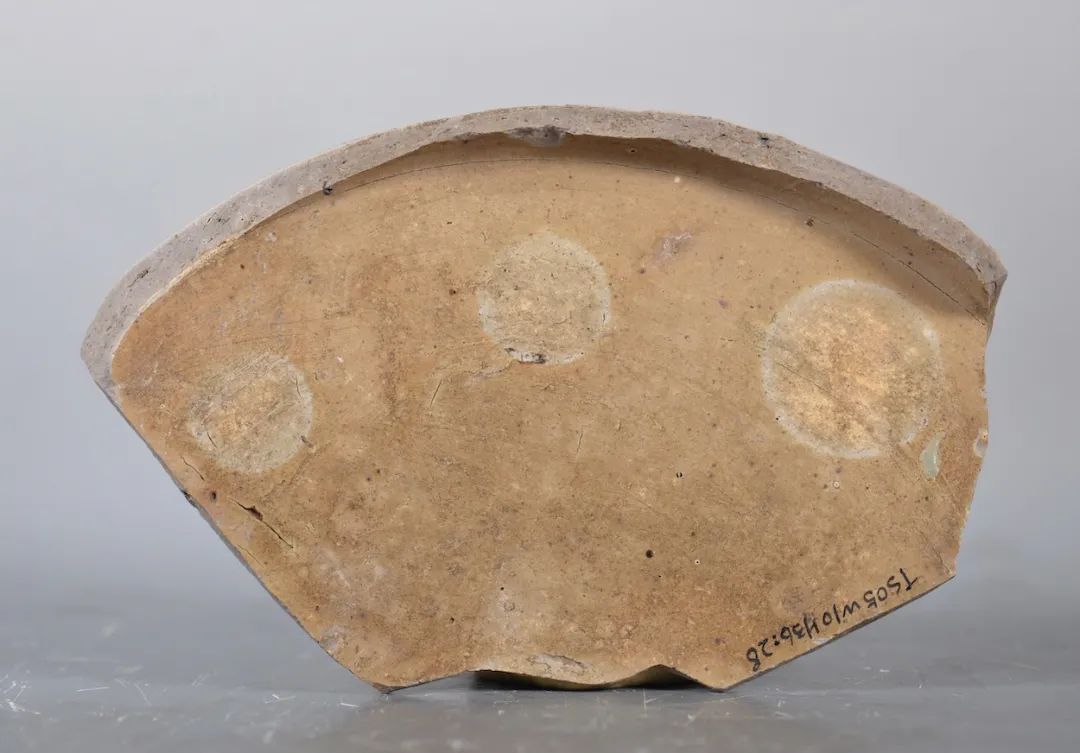
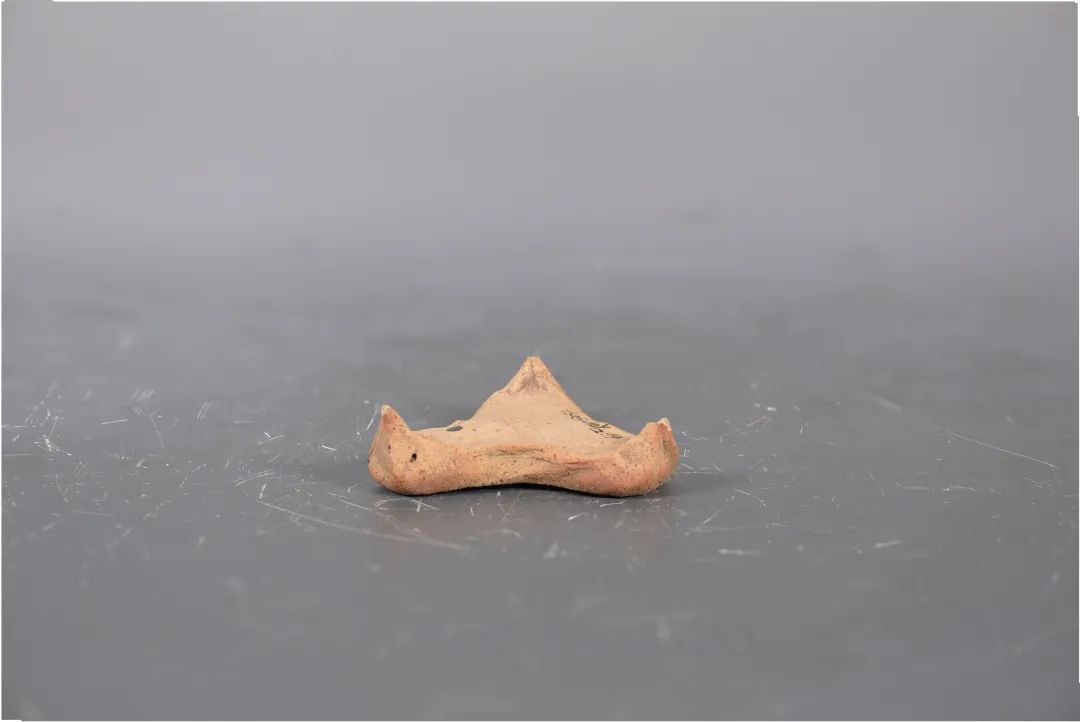
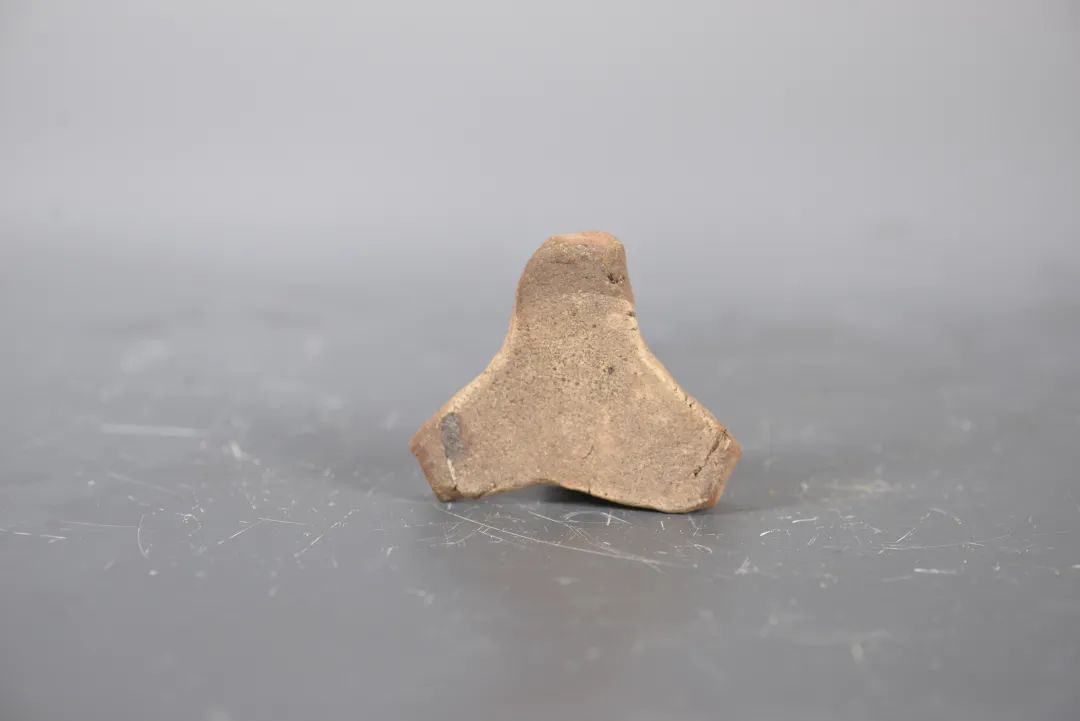

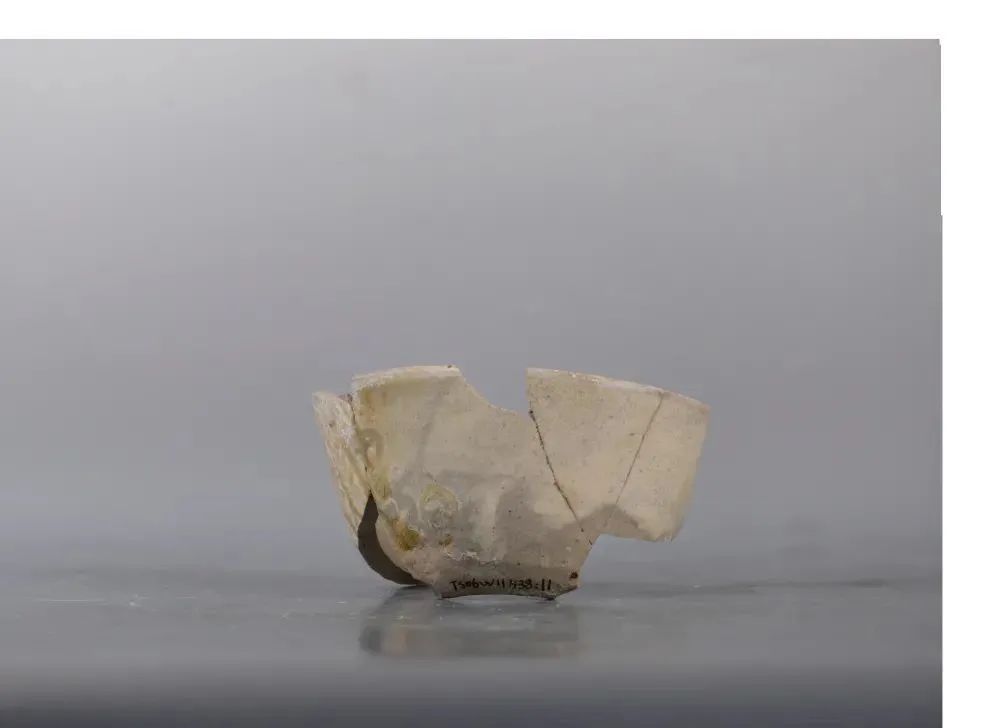
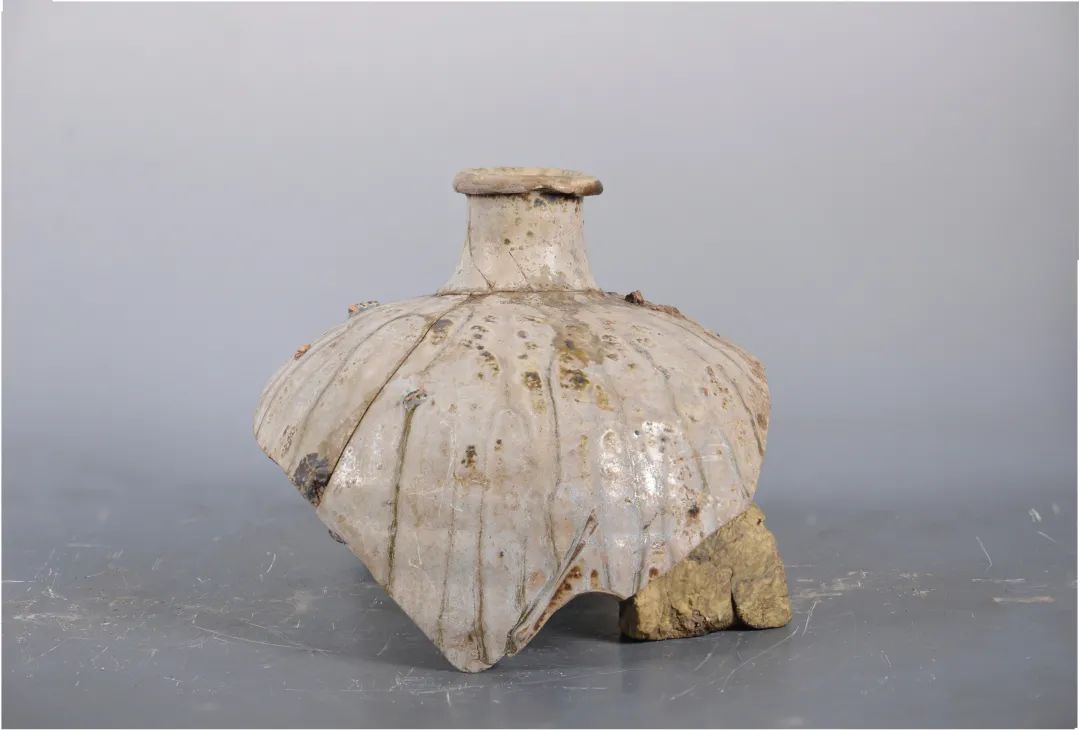
From the analysis of the remaining relics of the porcelain kilns, the porcelain kilns are all horseshoe-shaped steamed bread kilns, which are composed of a fire chamber, a kiln room and a flue. The ventilation duct of the kiln should be on the working surface, but it has been damaged and cannot be confirmed. A large amount of charcoal ash was found in the fire chamber, proving that the fuel used in the kiln was charcoal. Judging from the relics and unearthed relics, the use time of the porcelain kiln is very short, and there are not many kinds of fired products. Mushroom-shaped kiln furniture is the main supporting burning tool, and there are a small amount of trumpet-shaped kiln furniture. The unearthed celadon and cosmetic white porcelain should have been fired naked between such kiln furniture, but fine white porcelain used saggars. To be upside down, that is, the mouth is down and the feet are up.
The unearthed utensils have obvious characteristics of the Sui Dynasty or the early Tang Dynasty. We judge that the era of the porcelain kiln may be the Sui Dynasty. It has not been used for a long time. Inside the palace city, this is an important Sui Dynasty porcelain kiln. This kiln site is the earliest porcelain kiln site discovered in Shanxi, which fills the gap of relevant research and is of great significance in the study of ancient Chinese ceramics.
(This article was originally published in Wenbo China, author units: Shanxi Provincial Institute of Archaeology, Shanxi Provincial Institute of Ancient Architecture and Color Sculpture and Mural Protection)
Jinyang Ancient City Site is located in Jinyuan Town, Jinyuan District, southwest of Taiyuan City, with Longshan and Tianlong Mountain in the west and Fen River in the east, covering an area of more than 20 square kilometers. It was built in the Eastern Zhou Dynasty and was abandoned in the early Northern Song Dynasty. Archaeological work has been carried out since the 1960s, and it has been 60 years. Because the site is deeply buried and well-preserved, it is a major site protected by the national "Eleventh Five-Year Plan" to "14th Five-Year Plan". In October 2010, it was included in the list of the first batch of national archaeological site parks.
In 2021, in order to explore the relationship between the No. 2 building site and the No. 3 building site of Jinyuan Nursery, the Jinyang Ancient City Archaeological Team conducted archaeological excavations in the area between the two. 1 porcelain kiln site was discovered, and 3 porcelain kiln remains, 9 ash pits and nearly 10,000 pieces of porcelain were cleared out.
 The site of the porcelain kiln is located in the Jinyuan Nursery in the northwest area of the Jinyang Ancient City Site, 1,123 meters away from the Dayun Expressway in the west and 4,112 meters away from the Fen River in the east (Figure 1). It is superimposed under the Tang Dynasty cultural layer of Jinyang Ancient City, 60 meters west and 50 meters east, respectively, the No. 2 and No. 3 building sites of Jinyang Ancient City. The kiln site is poorly preserved, but the shape and structure of the foundation can be basically restored. . Among the relics unearthed, there are a large number of kiln furniture, porcelain pieces, slag and relics of the same period.
The site of the porcelain kiln is located in the Jinyuan Nursery in the northwest area of the Jinyang Ancient City Site, 1,123 meters away from the Dayun Expressway in the west and 4,112 meters away from the Fen River in the east (Figure 1). It is superimposed under the Tang Dynasty cultural layer of Jinyang Ancient City, 60 meters west and 50 meters east, respectively, the No. 2 and No. 3 building sites of Jinyang Ancient City. The kiln site is poorly preserved, but the shape and structure of the foundation can be basically restored. . Among the relics unearthed, there are a large number of kiln furniture, porcelain pieces, slag and relics of the same period. The relatively well-preserved of the three kiln remains is the No. 2 kiln (Y2). The kiln is located in the southwest of TS05W10 and the southeast of TS05W11. The distance to the north is 2.2 meters from Y1, parallel to Y1, the direction is 108°, and 2.4 meters from the surface. Y2 is a horseshoe-shaped steamed bread kiln, with an east-west length of 5.6 (from the east end of the fire chamber to the west end of the kiln bed sintering surface), a north-south width of 3.4 (the outer ends of the fire chamber retaining wall), and a depth of 1.26 meters (from the fire chamber bottom to the kiln bed sintering surface) . Due to the serious damage, only the burner part and the sintered surface of the kiln bed remained (Fig. 2).
The relatively well-preserved of the three kiln remains is the No. 2 kiln (Y2). The kiln is located in the southwest of TS05W10 and the southeast of TS05W11. The distance to the north is 2.2 meters from Y1, parallel to Y1, the direction is 108°, and 2.4 meters from the surface. Y2 is a horseshoe-shaped steamed bread kiln, with an east-west length of 5.6 (from the east end of the fire chamber to the west end of the kiln bed sintering surface), a north-south width of 3.4 (the outer ends of the fire chamber retaining wall), and a depth of 1.26 meters (from the fire chamber bottom to the kiln bed sintering surface) . Due to the serious damage, only the burner part and the sintered surface of the kiln bed remained (Fig. 2). 
Figure 2 Jinyang Ancient City No. 2 Kiln (East-West)
The plane of the fire chamber is nearly trapezoidal, and the section is also trapezoidal, the mouth is larger than the bottom, and the bottom is flat. The east-west length is 3, the north-south width is 3.4, and the depth remains 1.06-1.26 meters. Remains of the fire chamber are the west wall fire wall and the east, west and south fire chamber walls. Both the fire wall and the fire chamber walls are built with large refractory bricks with a length of 33, a width of 16 and a thickness of 8 cm, and the highest remaining 13 floors. The firewall is stacked in a hierarchical manner from bottom to top, with a total of 13 floors. On the north side of the fire wall, there is a blue-gray sintered surface with a width of about 0.4 meters. There is sintered refractory mud on the four walls. The upper part of the fire chamber is filled with reddish-brown soil, mixed with a large amount of red-burned soil, and there are disorganized kiln furniture near the bottom, and the bottom is 10-15 cm thick ashes. Many mushroom-shaped kiln columns, trumpet-shaped kiln columns, furnace bars, washers, gaskets, a large number of celadon-glazed porcelain pieces and a small amount of white-glazed porcelain pieces have been unearthed. The plane of the kiln bed is rectangular with rounded corners, and only 4-10 cm thick braised soil remains. The kiln wall, flue and other related relics no longer exist. The kiln bed is 2.52 meters long from east to west and 2.72 meters wide from north to south.A total of more than 1,600 pieces of kiln furniture were unearthed in the excavation area of the kiln site. The kiln furniture mainly consists of supports and cushions. and trumpet-shaped kiln columns; mushroom-shaped and trumpet-shaped kiln furniture are made of sand-filled refractory materials, and cushions are generally adhered to them; the saggar (Fig. There are white porcelain rims and smoked foot marks, which are used for firing small pieces of fine white porcelain. The round head bar has a porcelain tire and a sand-filled refractory material, and its surface is coated with a layer of yellow-green sand-filled refractory paint. The pad has washers, pad rings, pad strips, pad blocks and three-pronged support nails (Figure 5).

Figure 3 Mushroom-shaped kiln column (specimen TS05W10Y1:13)

Figure 4 The inner wall of the saggar (specimen S05W10H36:28)

Figure 5 The side of the three-pronged nail (specimen TS05W10Y2: 14)

Figure 5 The back of the three-pronged nail (specimen TS05W10Y2: 14)
The porcelain pieces unearthed in the excavation area are mainly celadon and white porcelain, and there are also two plain-bodied porcelain sculptures. The main identifiable types of white porcelain are jars, bowls, cups, bowls and lids (Fig. 6); the glaze color is mostly white with greenish or yellowish white, and basically thick white makeup soil is applied (Fig. 6). 7), some of the glazes are severely eroded and have lost their luster; some are well preserved, and the glazes have finely broken pieces. In addition, a very small amount of fine white porcelain was unearthed, and the glaze was aqua green, and the light was transparent. The main identifiable types of celadon are pots, urns, bowls, basins, bowls, bottles, lampstands, spinning wheels, etc. (Figure 8); The glaze surface is severely eroded and lost its light, some are seriously peeled off, some are very uneven in thickness, some are well preserved, and the jade texture is very strong; the porcelain body is mainly mud, and only one plain body porcelain is Muddy sand. Whether it is white porcelain or celadon, the fetal color is mostly blue-gray, gray-white and yellow-white, and most of the utensils show reddish-brown in the exposed part of the body. The firing temperature of large-sized celadon ware is generally higher, and the firing temperature of small-sized cosmetic white porcelain is mostly Slightly lower, and fine white porcelain has a higher heat.
Figure 6 Fine white porcelain cup (specimen TS05W10H36: 32)

Figure 7. Cosmetic white porcelain bowl (specimen TS06W11H38:11)

Figure 8 Celadon long neck arc belly jar (specimen TS05W10H36:12)
The Jinyang Ancient City Porcelain Kiln Site is located in the Jinyang Ancient City Site, in the southern part of the Palace City from the Northern Dynasties to the Tang Dynasty. The excavated porcelain kiln site opens at the ⑤b level. Layer ⑤b is the cultural layer in the early Tang Dynasty, and below it is the foundation site of the Northern Dynasties.From the analysis of the remaining relics of the porcelain kilns, the porcelain kilns are all horseshoe-shaped steamed bread kilns, which are composed of a fire chamber, a kiln room and a flue. The ventilation duct of the kiln should be on the working surface, but it has been damaged and cannot be confirmed. A large amount of charcoal ash was found in the fire chamber, proving that the fuel used in the kiln was charcoal. Judging from the relics and unearthed relics, the use time of the porcelain kiln is very short, and there are not many kinds of fired products. Mushroom-shaped kiln furniture is the main supporting burning tool, and there are a small amount of trumpet-shaped kiln furniture. The unearthed celadon and cosmetic white porcelain should have been fired naked between such kiln furniture, but fine white porcelain used saggars. To be upside down, that is, the mouth is down and the feet are up.
The unearthed utensils have obvious characteristics of the Sui Dynasty or the early Tang Dynasty. We judge that the era of the porcelain kiln may be the Sui Dynasty. It has not been used for a long time. Inside the palace city, this is an important Sui Dynasty porcelain kiln. This kiln site is the earliest porcelain kiln site discovered in Shanxi, which fills the gap of relevant research and is of great significance in the study of ancient Chinese ceramics.
(This article was originally published in Wenbo China, author units: Shanxi Provincial Institute of Archaeology, Shanxi Provincial Institute of Ancient Architecture and Color Sculpture and Mural Protection)
Related Posts